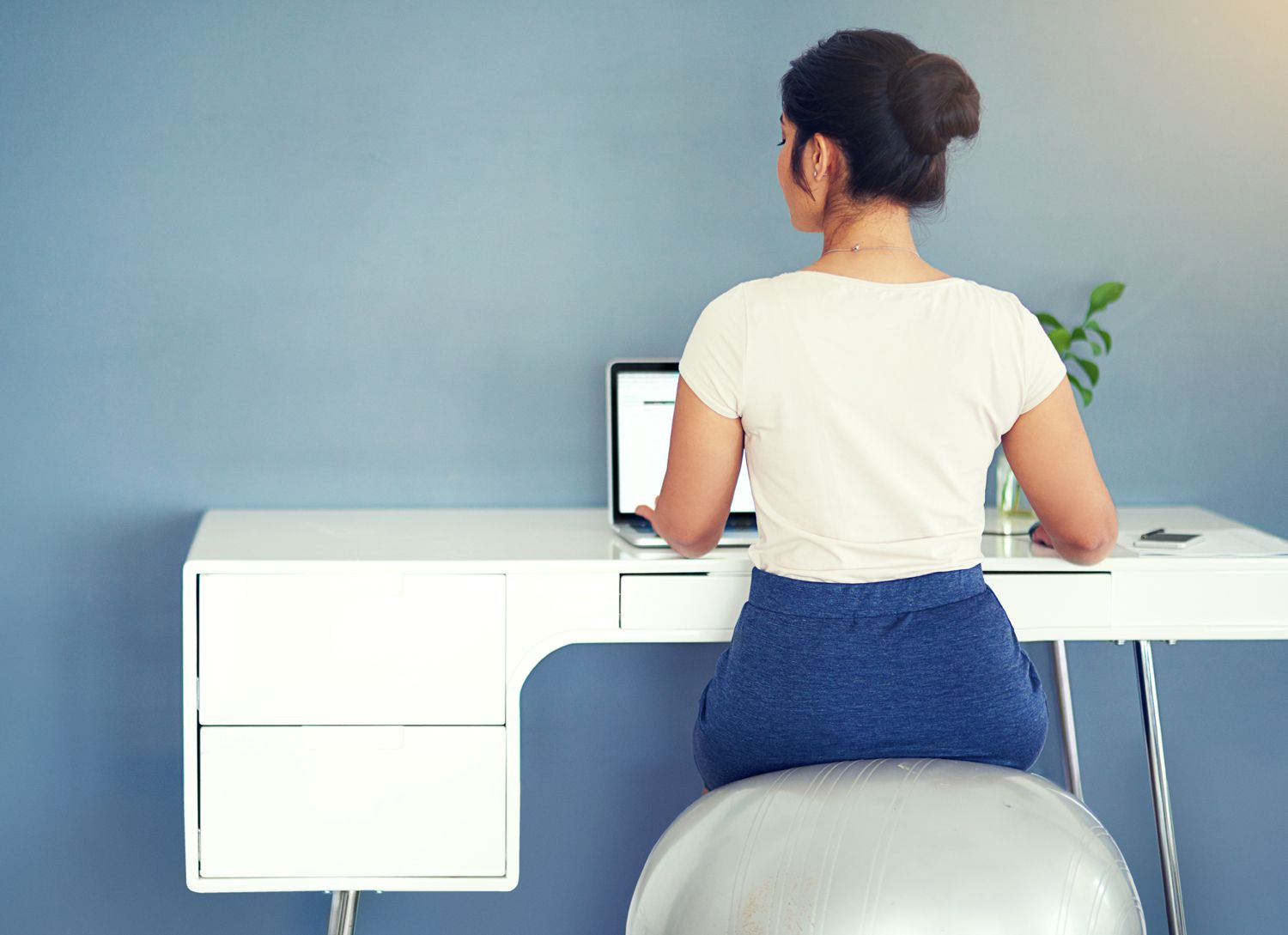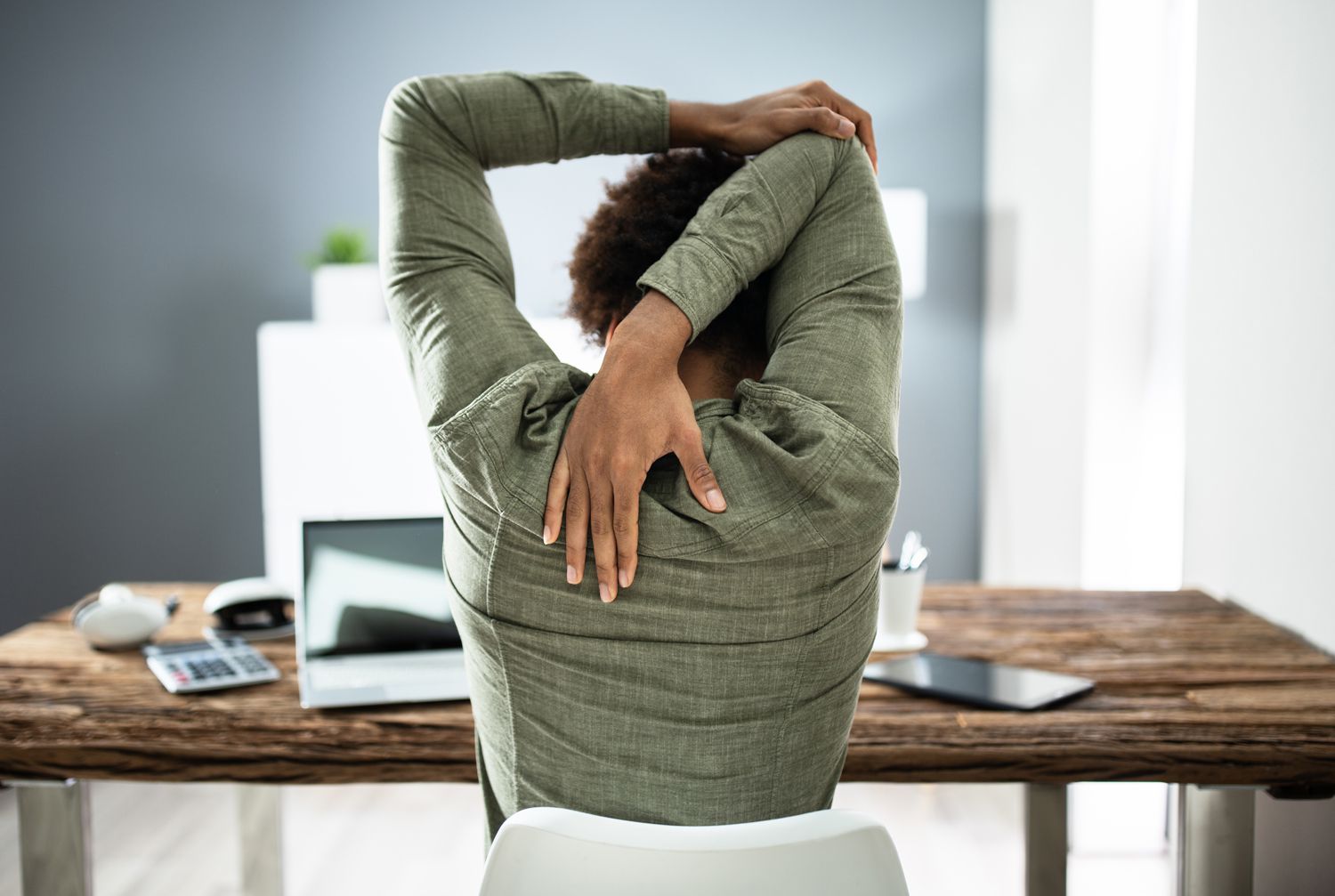7 Quick Tweaks to Make Working from Home Easier on Your Body

New year, same pandemic. What started as a few weeks in lockdown is nearing its one-year anniversary, but that doesn't mean our working-from-home habits have gotten any better. Make your resolution to take it easier on your body and brain with these expert-approved tweaks that will help keep you in good shape for the unforeseeable future.
1. Get comfortable
Your neck is a common area for stress-related pain and muscle tension, and as you can guess, stooping to squint at a laptop isn't helping the matter. Set reminders to relax your shoulders in order to prevent muscle tightening in the area. With your computer monitor arms-length in front of you and your elbows near your side, rest your wrists on your keyboard in a neutral position to lessen chances of getting carpal tunnel overtime.
Sitting up straight in your chair, your feet should be flat on the floor and the top of your monitor should be at eye level. This prevents you from hunching forward and reduces tension, headaches, and stress in your upper back, says Dr. Reid Gehring, assistant professor of physical therapy at Texas Tech University Health Sciences Center.
For those with laptops working from home long-term, Gehring recommends asking your employer for external devices such as a wireless keyboard and monitor to make your set up more ergonomic.
2. Try not to work from your bed (but if you do, use your pillows)
We get it: Working from your bed is cozy, convenient, and eliminates the last four feet of commute you had left. Still, doing cognitively demanding work in a place meant for rest isn't the best idea. The more you get acclimated to using your bed as a workspace, the harder it may be for your body to fall asleep there when you need to.
"You're going to associate being in bed with being awake, being alert, and engaging in deep thought, and that's the worst place now to be doing that," says Michael Serra, associate professor of cognitive psychology at Texas Tech University.
That, coupled with the struggles of keeping your laptop at eye-level and maintaining good posture, makes working from your bed harmful on your body in the long-term.
Still, not everyone has a choice. If you have to do work on your mattress, try leaning against your headboard or wall and keep a small pillow behind your lower back for support, Gehring says. You can use a laptop desk to elevate your screen, or stack a couple of pillows underneath it for the same effect.
3. Get dressed in the morning
Another groan, but hear us out. Think about how you feel after you shower, put on a nice outfit, or tidy up your space. It may be hard to work up the motivation to do those things (especially if no one will see you anyway), but taking steps to "get ready" puts you in a positive headspace.
"If you don't do things that help you have some degree of success or put you in a posture where you're 'put together', then your actions and your attitudes and your mental state might be altered," says Dr. Laura Murray, senior scientist and clinical psychologist at Johns Hopkins.
That doesn't mean you should never have a pajama day (those can help your mental state sometimes, too) but it's something to consider when working from home long-term. Try starting small, getting dressed one or two days a week beyond the blazer and sweats combo.

4. Schedule your breaks and other non-work activities
When your office is your house, it can be all too easy to blur the boundaries of when the workday ends and your home life begins. However, it's important to set aside some time to rest and recharge to avoid burnout. If you're in the zone and are wary about stepping away for too long, try breaking up your break time instead, scattering 10 minute periods throughout your day, says Dr. Erin Berman, clinical psychologist at the National Institute of Mental Health.
Just as you would schedule time out of your day for work activities, setting aside parts of your day for non-work activities can help you reestablish some of those boundaries, Serra adds. Avoid scheduling meetings at the time you plan to eat lunch. Remind yourself to log off when you're supposed to, so you can get started on dinner or call a friend.
5. Have healthy foods handy
It can be tempting to substitute meals for quick snacks or skip them altogether while working from home. While it's okay to treat yourself to sweets every once in a while, foods that are high in sugars and fats make blood sugar spike, then crash, which causes us to feel sluggish to the point where we feel like we need more.
That change in diet, plus an increase in sedentary behavior, is a recipe for problems down the line, says Charmaine Jones, a registered dietitian based in Washington D.C.
"You might get that quick energy, but your body doesn't feel that good," Jones points out. "But when you eat something hydrating and filled with nutrients like fruit coupled with nuts, it doesn't give you that sluggish feel."
Preparing your lunch in advance and having pre-cut vegetables and other healthy snacks at the ready are just some of the ways to help limit compulsive eating, said a spokesperson for the Health and Human Services Office of Disease Prevention and Health Promotion in an email.

6. Stretch it out
Gehring recommends laying on your stomach for 10 minutes to alleviate back pain caused by sitting in one place for too long. It's a physical therapy technique that Gehring remembers doing a lot while working on his dissertation years ago.
"Sometimes, sitting in a flexed position is tough on the back. Just taking a break from that, laying down on your stomach, that puts your spine in a different position and it can be quite pain relieving," says Gehring.
If you don't feel like laying on the floor, try this variation: Place your hands at the small of your back and arch yourself backward as far as you can while keeping your knees straight.

7. Get moving
For adults, staying active helps prevent several types of cancer and reduces the risk of heart disease, stroke, high blood pressure, and other health risks. That's why moving around is so important.
"By engaging in exercise and physical activity, you become more resistant to those pains that accumulate from sitting in front of your computer not moving," says Dr. Chris Mojock, clinical associate professor in exercise and sports science at the University of Georgia.
The key is to change positions, even if that means taking a phone call while standing or taking a walk outside or around your home during the day. It can also be helpful to incorporate movement into the routines you already have, like walking to pick up lunch rather than driving or having it delivered.
"Even five minutes of physical activity has real health benefits. Everything counts with movement," said the HHS Office of Disease Prevention and Health Promotion spokesperson.
Source: Read Full Article



